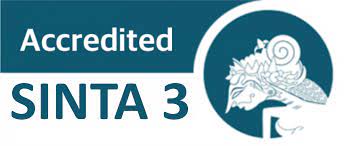TEACHING VOCABULARY USING THE UNISONO SINGING METHOD TO STUDENTS AT MTS HIFZHIL QUR’AN ISLAMIC CENTER FOUNDATION NORTH SUMATRA
Abstract
Keywords
Full Text:
PDFReferences
Ahmad Izzan. (2011). Metodologi Pembelajaran Bahasa Arab (Edisi ke 4; U. S. Ariyasa, R. Wirasetiadi, & A. Supriatna, eds.). Bandung: HUMANIORA.
Alam, A., & Khotimah, K. (2021). PENINGKATAN PENGUASAAN KOSA KATA BAHASA ARAB MELALUI GAME ARABIC TREASURE HUNTER. MUHIBBUL ARABIYAH: Jurnal Pendidikan Bahasa Arab, 1(1), 58–77. https://doi.org/10.35719/pba.v1i1.9
Aldena, S. (2021). تطوير الأغاني للأطفال لترقية استيعاب المفردات العربية. Jurnal Al-Maqayis: Jurnal Pendidikan Bahasa Arab Dan Kebahasaaraban, 8(1), 85–98. https://doi.org/10.18592/jams.v8i1.4800
Azzahra, S. (2023). Pengaruh Metode Bernyanyi terhadap Penguasaan Kosakata Bahasa Inggris pada Siswa SD. Jurnal Pendidikan Guru Sekolah Dasar, 1(2), 9. https://doi.org/10.47134/pgsd.v1i2.142
Basam, F. (2022). Motivasi Dan Hasil Belajar IPA Siswa Kelas VII Dalam Pembelajaran Model Kooperatif Numbered Heads Together. Jurnal Riset Pendidikan Dasar, 05(1), 100–106.
Firdana, K., & Ardipal, A. (2020). PENINGKATAN KEMAMPUAN BERNYANYI SISWA SECARA UNISONO MENGGUNAKAN METODE TUTOR SEBAYA DI KELAS VII.1 SMPN 6 SIJUNJUNG. Jurnal Sendratasik, 9(4), 117. https://doi.org/10.24036/jsu.v9i1.109558
Holimi, M., & Faizah, N. (2021). Pembelajaran mufrodat dengan metode bernyanyi di gubuk baca kalpataru dusun bendrong. Muhadasah: Jurnal Pendidikan Bahasa Arab, 3(2), 120–138.
Imron, A., & Fajriyah, D. F. (2021). Penggunaan Metode Bernyanyi dalam Menghafal Mufrodat (Kosakata) Bahasa Arab di MI. Dawuh Guru: Jurnal Pendidikan MI/SD, 1(1), 41–56. https://doi.org/10.35878/guru.v1i1.255
Malik, A., Purnamasari, P. D., & Syahid, A. (2022). Penerapan Metode Bernyanyi dalam Meningkatkan Hasil Belajar pada Pembelajaran Pendidikan Agama Islam. Education and Learning Journal, 3(1), 61. https://doi.org/10.33096/eljour.v3i1.157
Munir. (2017). Perencanaan Sistem Pengajaran Bahasa Arab (Edisi 1; Irfan Fahmi, ed.). Jakarta: KENCANA.
Sinaga, S. S., Susanto, S., Ganap, V., & Rohidi, T. R. (2018). Musical Activity in The Music Learning Process Through Children Songs in Primary School Level. Harmonia: Journal of Arts Research and Education, 18(1), 45–51. https://doi.org/10.15294/harmonia.v18i1.12508
Sofyan Slamet. (2020). Penggunaan Metode Bernyanyi Dalam Pembelajaran Mufrodat Bahasa Arab Kelas 7 MTs Ma’arif Slamet Indramayu. Syntax Idea, 2(11), 953–961. https://doi.org/10.1016/j.fcr.2017.06.020
Syamsiar dan Asyikin. (2021). Peningkatan Mufradat Dalam Pembelajaran Bahasa Arab Dengan Metode Bernyanyi. Jurnal Pendais, 3(1), 46–62. Retrieved from https://jurnal.uit.ac.id/JPAIs/article/view/1065/780
Syamsuddin Asyrofi. (2014). Model, Strategi & Permainan Edukatif Dalam Pembelajaran Bahasa Arab (Edisi 1; Toni Pransiska, ed.). Yogyakarta: Aura Pustaka.
Warmansyah, J., Nurlaila, N., Mudinillah, A., & Fitri, A. D. (2023). THE UTILIZATION OF CANVA APPLICATION IN SUPPORTING EARLY CHILDHOOD ARABIC LANGUAGE LEARNING: TEACHERS’ PERCEPTIONS / PEMANFAATAN APLIKASI CANVA DALAM MEDUKUNG PEMBELAJARAN BAHASA ARAB ANAK USIA DINI: PERSEPSI GURU. Lughawiyah: Journal of Arabic Education and Linguistics, 5(2), 141. https://doi.org/10.31958/lughawiyah.v5i2.10781
Widiya Yul, & Riko Andrian. (2022). PENERAPAN METODE BERNYANYI DALAM PEMBELAJARAN KOSAKATA BAHASA ARAB SEBAGAI UPAYA MENINGKATKAN MOTIVASI BELAJAR SISWA. El-Fata: Jurnal Ilmu Tarbiyah, 2(02), 95–103. https://doi.org/10.36420/eft.v2i02.157
عبد الله قلش. (2017). منهجية البحث العلمي (مقياس). الجزائر: جامعة حسيبة بن بولي الشلف.
ماهر شعبان عبد الباري. (2011). إستراتيجيات تعليم المفردات (الأولى). عمان: دار المسيرة. Retrieved from www.massira.jo
محمد علي الخولي. (1988). تعليم اللغة: حالات وتعليقات (الأولي). الرياض: جامعة الملك سعود.
DOI: https://doi.org/10.18860/abj.v9i1.26856
Refbacks
- There are currently no refbacks.
Copyright (c) 2024 Siti Nur Rafiza
License URL: https://creativecommons.org/licenses/by-sa/4.0/
...............................................................................................................................................................
Mailing Address:
Ruang Jurnal Abjadia, Fakultas Ilmu Tarbiyah dan Keguruan (FITK)
Universitas Islam Negeri (UIN) Maulana Malik Ibrahim Malang
Jalan Gajayana 50 Malang 65144, Jawa Timur, Indonesia
Phone/Faximile: (+62341) 552398, Phonsel: +6281333666063
Website: http://ejournal.uin-malang.ac.id/index.php/abjadia
Email: abjadia@uin-malang.com
Abjadia: International Journal of Education. This work is licensed under a Creative Commons Attribution-ShareAlike 4.0 International License.
...............................................................................................................................................................
Indexed by:






